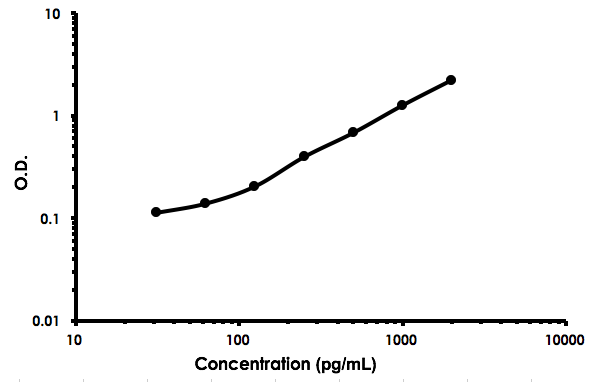Mouse S100A9 ELISA Kit (ab213887)
Key features and details
- Sensitivity: 10 pg/ml
- Range: 31.2 pg/ml - 2000 pg/ml
- Sample type: Cell culture supernatant, Cell Lysate, EDTA Plasma, Hep Plasma, Serum
- Detection method: Colorimetric
- Assay type: Sandwich (quantitative)
- Reacts with: Mouse
Properties
-
Storage instructions
Store at -20°C. Please refer to protocols. -
Components Identifier 1 x 96 tests ABC Diluent Buffer Blue Cap 1 x 12ml Adhesive Plate Seal 4 units Antibody Diluent Buffer Green Cap 1 x 12ml Anti-Mouse S100A9 coated Microplate (12 x 8 wells) 1 unit Avidin-Biotin-Peroxidase Complex (ABC) 1 x 100µl Biotinylated anti- Mouse S100A9 antibody 1 x 130µl Lyophilized recombinant Mouse S100A9 standard 2 vials Sample Diluent Buffer Green Cap 1 x 30ml TMB Color Developing Agent Black Cap 1 x 10ml TMB Stop Solution Yellow Cap 1 x 10ml -
Research areas
-
Function
Calcium-binding protein. Has antimicrobial activity towards bacteria and fungi. Important for resistance to invasion by pathogenic bacteria. Up-regulates transcription of genes that are under the control of NF-kappa-B. Plays a role in the development of endotoxic shock in response to bacterial lipopolysaccharide (LPS) (By similarity). Promotes tubulin polymerization when unphosphorylated. Promotes phagocyte migration and infiltration of granulocytes at sites of wounding. Plays a role as a pro-inflammatory mediator in acute and chronic inflammation and up-regulates the release of IL8 and cell-surface expression of ICAM1. Extracellular calprotectin binds to target cells and promotes apoptosis. Antimicrobial and proapoptotic activity is inhibited by zinc ions. -
Tissue specificity
Expressed by macrophages in acutely inflammed tissues and in chronic inflammation. Detected in peripheral blood leukocytes, in neutrophils and granulocytes. Detected at sites of vascular inflammation (at protein level). Also expressed in epithelial cells constitutively or induced during dermatoses. -
Sequence similarities
Belongs to the S-100 family.
Contains 2 EF-hand domains. -
Post-translational
modificationsPhosphorylated. Phosphorylation inhibits activation of tubulin polymerization. -
Cellular localization
Secreted. Cytoplasm. Cytoplasm > cytoskeleton. Cell membrane. Associates with tubulin filaments in activated monocytes. Targeted to the cell surface upon calcium influx. Released from blood leukocytes upon exposure to CSF2/GM-CSF, bacterial lipopolysaccharide (LPS) and during inflammatory processes. Serum levels are high in patients suffering from chronic inflammation. - Information by UniProt
-
Alternative names
- Leukocyte L1 complex heavy chain
- 60B8AG
- CAGB
see all -
Database links
- Entrez Gene: 20202 Mouse
- SwissProt: P31725 Mouse
- Unigene: 2128 Mouse







